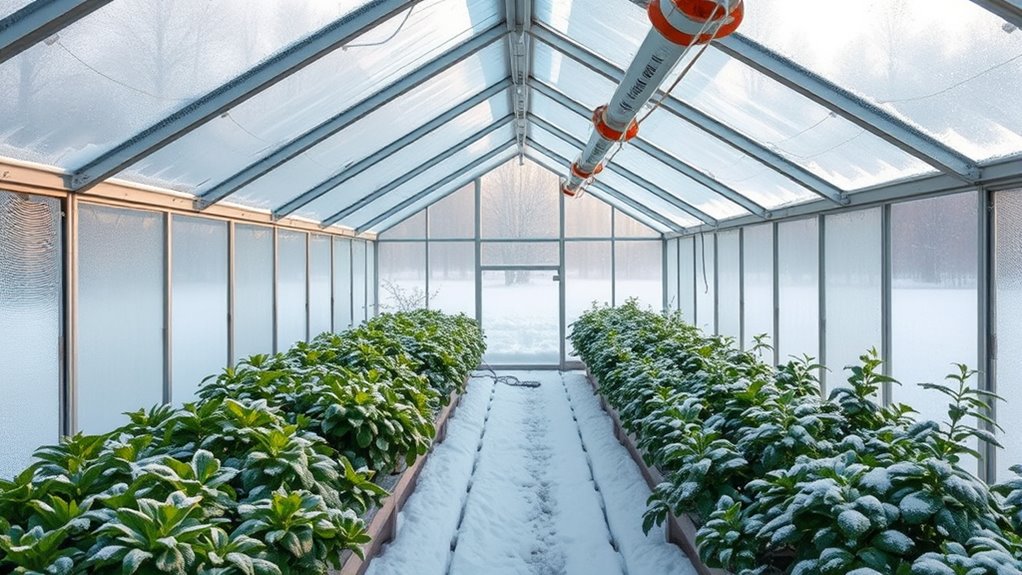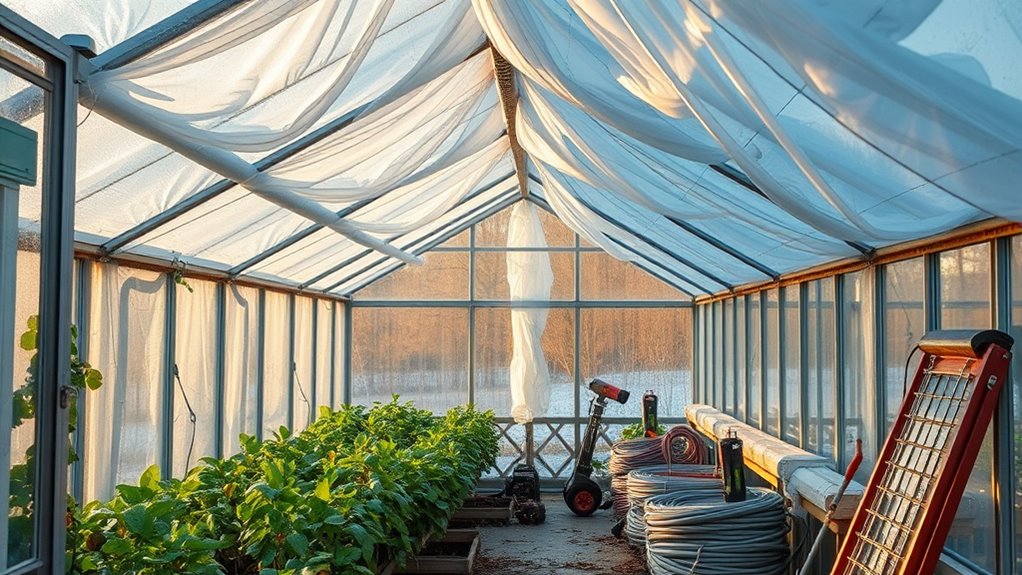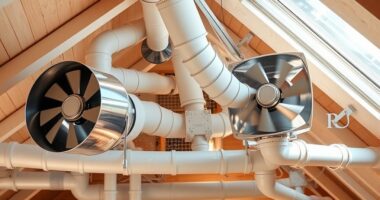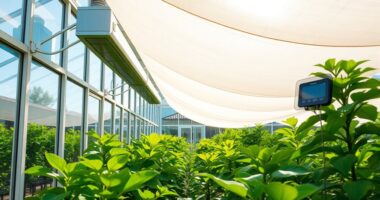To winterize your greenhouse, start by sealing gaps with weatherstripping and insulation materials like bubble wrap or foam boards. Add thermal curtains or tarps to retain heat, and consider installing heaters such as electric or propane units, with thermostatic controls for efficiency. Regularly test your system and monitor temperatures to prevent frost damage and extend your growing season. If you want to learn how to create a warm, safe environment all winter long, keep exploring these strategies.
Key Takeaways
- Insulate greenhouse panels with bubble wrap, polyethylene film, or foam boards to reduce heat loss.
- Seal gaps and cracks around doors, vents, and foundation with weatherstripping and sealants.
- Use thermal curtains or tarps to enhance heat retention inside the greenhouse.
- Install and test heating systems such as electric, propane, or radiant floor heaters before winter.
- Monitor temperatures regularly and adjust insulation and heating to maintain optimal growing conditions.

Are you prepared to protect your greenhouse during the winter months? As temperatures drop, it’s essential to ensure your plants stay warm and healthy. The key to winterizing your greenhouse lies in effective insulation techniques and choosing the right heating options. These steps help you maintain a stable environment, preventing frost damage and prolonging your growing season.
Start by focusing on insulation techniques. You want to minimize heat loss as much as possible, so consider adding bubble wrap or polyethylene film to the inside of your greenhouse panels. These materials trap air, creating a layer of insulation that keeps cold air out and warmth in. You can also install weatherstripping around doors and vents to prevent drafts. For larger gaps or cracks, use sealants or foam strips. If your greenhouse has a foundation, insulate it with foam boards or insulating blankets to prevent cold from seeping in from the ground. Additionally, hanging thermal curtains or using tarp covers over the glazing can further improve heat retention at night. Proper insulation is crucial because it reduces the workload on your heating system, saving energy and lowering costs.
Enhance insulation with bubble wrap, weatherstripping, and thermal curtains to keep your greenhouse warm and energy-efficient during winter.
When it comes to heating options, you need a system that balances efficiency and safety. Electric heaters are popular because they’re easy to operate and don’t produce fumes, making them ideal for small to medium-sized greenhouses. For larger setups, propane or natural gas heaters might be more effective, but they require proper ventilation and safety measures. Radiant floor heating is another excellent choice, especially if you’re growing sensitive plants that need consistent warmth from the ground up. You might also consider installing a thermostatic control system to regulate temperature automatically, preventing overheating or excessive cooling. Combining insulation techniques with the right heating options ensures a warm environment without wasting energy. Remember, the goal is to keep the temperature above freezing, ideally around 45-60°F, depending on your plants’ needs. Incorporating climate control systems can further optimize your greenhouse environment during winter.
Before winter hits full force, test your heating system to make sure it works efficiently. Check insulation points for gaps and reinforce them if necessary. Keep a close eye on the weather forecast and be ready to adjust your heating and insulation strategies as conditions change. With the right combination of insulation techniques and heating options, you’ll create a resilient environment that protects your plants from harsh winter cold. This preparation not only preserves your current crops but also sets the stage for a thriving growing season once spring arrives. Taking these proactive steps ensures your greenhouse remains a warm, safe haven for your plants all winter long.
Frequently Asked Questions
How Do I Prevent Frost Damage Inside My Greenhouse?
To prevent frost damage inside your greenhouse, focus on effective frost prevention methods. You should enhance greenhouse insulation by installing bubble wrap or thermal blankets to retain heat. Keep the temperature consistent by using a heater or heat lamps during cold nights. Ventilate properly to avoid excess moisture, which can cause frost. Regularly monitor temperatures with a thermometer, and act quickly if frost threatens your plants. These steps will help keep your greenhouse plants safe and healthy.
What Heating Options Are Best for a Greenhouse?
When choosing a heating system for your greenhouse, it’s wise to consider your goals and budget. Think of greenhouse insulation as your secret weapon—keeping heat in while reducing energy use. Compare various heating systems, like electric, gas, or infrared options, to find the best fit. You’ll want a setup that maintains consistent warmth without overextending your resources, ensuring your plants stay cozy all season long.
How Often Should I Check for Pests During Winter?
During winter, you should regularly perform pest monitoring and winter inspections to catch issues early. Check your greenhouse at least once every two weeks, focusing on plants, vents, and hidden corners. Pests can still thrive in colder months, so staying vigilant helps prevent infestations. Keep an eye out for signs like chewed leaves or sticky residue, and address problems promptly to protect your plants throughout the winter.
Can I Grow Tropical Plants in Winter?
Yes, you can grow tropical plants in winter, but you need to focus on tropical plant care and winter plant protection. Keep your greenhouse warm and maintain high humidity levels, as tropical plants thrive in these conditions. Use heaters if necessary, and guarantee proper insulation. Regularly check for pests, and water sparingly. With proper attention, your tropical plants can flourish even during colder months.
How Do I Manage Humidity Levels in Winter?
Managing humidity levels in winter is vital for healthy plants. You should regularly check your humidifier maintenance to prevent mold and guarantee proper moisture. Use effective ventilation strategies, like opening vents or using exhaust fans, to prevent excess humidity buildup. Balancing humidity prevents fungal issues and keeps your plants thriving. Keep a close eye on indoor conditions, adjusting your methods as needed to maintain ideal moisture levels during cold months.
Conclusion
By winterizing your greenhouse, you protect your plants and make certain a healthy growing season ahead. Did you know that properly insulated greenhouses can reduce heating costs by up to 50%? Taking these steps now not only preserves your plants but also saves you money. Don’t wait until the cold hits—prepare today to enjoy a thriving greenhouse come spring. With a little effort, you’ll keep your plants cozy and your gardening success unstoppable.









